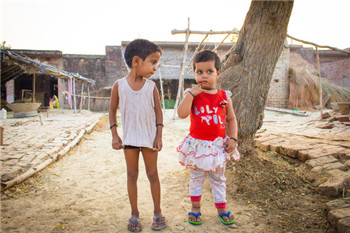(单词翻译:单击)

LUCKNOW, India — That’s Mishty Yadav on the right. At 28 months, she looked huge in her mother’s arms, as if she spent nights on a gold throne dipping cookies into buffalo milk.
印度勒克瑙——右边的是米什蒂·亚达夫(Mishty Yadav)。她28个月大,在母亲怀里看起来体格硕大,仿佛夜里都是坐在黄金宝座上吃着饼干蘸牛奶。
But it turns out the reason she caught my eye was because, in contrast to so many children, Mishty is healthy. And here in the Indian state of Uttar Pradesh, where the majority of children under the age of five are malnourished and stunted, what looks normal starts to change.
不过,后来我发现,她之所以引起了我的关注,是因为她很健康,与太多的孩子不一样。这里是印度北方邦,多数五岁以下的婴幼儿营养不良、发育迟缓。什么叫做正常,也就有了变化。
In rural villages like this one a normal child looks like 5-year-old Shanvi Yadav, there on the left — very small and very thin.
在这样的乡村里,“正常”孩子长得像左边的五岁大的莎薇·亚达夫(Shanvi Yadav)一样——又瘦又小。
So Mishty is barely half Shanvi’s age but may weigh even more than her. They live about 100 feet from each other, but their opportunities to grow up healthy, both physically and mentally, are vastly different. When I met them and spoke to their families, I was struck by how early child-rearing practices were likely to result in dramatically different life trajectories for the two kids. When most mothers in these villages care for their children, they do so based on traditional practices. And tradition, even when misinformed, can be hard to go against.
因此,尽管米什蒂刚到莎薇一半的年纪,体重却可能比她还大。她们住的地方相距大约百尺,身心健康成长的几率却有着天壤之别。当我认识她们并与其家人谈话之后,我深有感触:早期育儿实践很可能会让这两个孩子走上截然不同的生活轨迹。这些乡村里的母亲养育孩子的时候,多数人遵循的是传统做法。而传统,即便是谬误,也会很难抗拒。
When Nicholas Kristof asked one mother in Jalim Kheda whether or not she was giving water to her month-old infant, she said she was not. Only breast milk. Hearing this, her mother-in-law and neighbors started scolding her for not giving the child water. Many villagers provide infants with water when it is hot to cool them off.
在贾里姆凯达,纪思道(Nicholas Kristof)询问了一位母亲是否给她一个月大的婴儿喂水。答案是否定的,她只喂母乳。听闻此言,她的婆婆和邻居开始训斥她没有让孩子喝水。天热的时候,许多村民会用给婴儿喂水的办法来给他们降温。
“Anything the baby is taking that is not breast milk [such as water] is replacing breast milk,” says Shawn Baker, head of nutrition for the Bill and Melinda Gates Foundation. “And breast milk has been designed over several million years of evolution to be the perfect nutrition. It’s perfectly synchronized to the infant’s needs.”
“婴儿摄入的任何除母乳之外的东西(比如水),都是在挤占母乳的空间,”比尔及梅林达·盖茨基金会(Bill and Melinda Gates Foundation)的营养议题总监肖恩·贝克(Shawn Baker)说。“经过几百万年的进化,母乳是最佳营养品。它与婴儿的需求完美契合。”
As peer pressure weighed on the mother, she finally gave in and said she would start giving her baby water. The influence of tradition is strong, and in many cases, unhealthy. A nutritionist with us hurriedly told the mom that she was on the right path and not to give water.
周围的压力落到了这位母亲身上,她最终投降,表示自己会开始给孩子喂水。传统的影响力是强大的,在很多情况下却并不健康。与我们同行的一名营养专家匆忙告诉她,她是对的,别给孩子喝水。
One of the best ways to break out of the cycle of misinformation is through education. That’s what Nisha Yadav, who earned a bachelor’s degree, credits for knowing how to raise Mishty.
打破这种谬误的一种最佳办法是教育。米什蒂的母亲尼莎·亚达夫(Nisha Yadav)拥有学士学位。正是因为教育,她懂得如何抚养自己的孩子。
When Nisha was pregnant with Mishty, she went to a private clinic to receive prenatal care. Every day she took iron and folic acid tablets as well as multivitamins. Iron tablets are key during pregnancy to prevent the mother from becoming anemic.
当尼莎怀着米什蒂的时候,她去了一家私人诊所来接受产前护理。每天她都要吃铁片和叶酸片,以及多种维生素。铁片是预防母亲在怀孕期间贫血的关键。
Mishty was born at a private hospital in Lucknow and started breast-feeding shortly after. Exclusive breast-feeding lasted six months, upon which complementary feeding was introduced. Nisha breast-fed for the recommended two years before stopping.
米什蒂在勒克瑙的一家私人医院出生,并且很快就开始了母乳喂养。纯母乳喂养持续了六个月,然后添加了辅食。尼莎根据推荐让母乳喂养持续了两年,最后才断奶。
Just down the road is a different story.
就在路的另一端,则是不一样的故事。
Babli Yadav, Shanvi’s mother, was taken out of school after eighth grade to help earn for the household. When Babli was pregnant, she was given iron and folic acid tablets but she didn’t take them because they made her feel nauseous.
莎薇的妈妈芭布里·亚达夫(Babli Yadav)在八年级后被迫辍学弥补家用。当芭布里怀孕的时候,她收到了铁片和叶酸片,但是没有吃,因为这些让她感到恶心。
Shanvi was born at home and breast-feeding didn’t begin until day 10. There is a myth that the mother’s milk should not be given during the first few days.
莎薇是在家里出生的,直到第10天才开始母乳喂养。当地有个错误观念,认为母亲在刚生下孩子的那几天是不能母乳喂养的。
“There’s a very strong tradition of giving honey or giving something before being given the breast,” says Baker. “But the early milk is incredibly rich in maternal antibodies. Everything the mother has been protected against is being transferred to protect the infant.”
“这里有一个很强的传统,在母乳喂养之前,要先给孩子蜂蜜或者其他的东西,”贝克说。“但初乳有着非常丰富的母源抗体。所有保护母亲的东西都会转移到婴儿身上。”
When Babli transitioned to breast-feeding, it was irregular, and eventually stopped after one year. Babli says their diet is poor.
当芭布里转为母乳喂养后,也不是很经常,并且最终在一年之后就停止了。芭布里说他们的饮食很差。
You can see the physical manifestation of malnutrition in the photo. But physical health is not the only concern. Studies show that cognitive development is severely hampered in malnourished children. They drop out of school earlier and are at a greater risk of dying.
你可以从照片中看到营养不良的切实表现。不过,身体健康并不是唯一的问题。研究表明,营养不良儿童的认知能力发育会受到严重阻碍。他们辍学较早,死亡的风险也更大。
On this trip I have been fascinated by the tension between factual knowledge and tradition. It has given me an appreciation for how difficult health interventions can be. Simply transmitting knowledge is very unlikely to change behavior. But looking at these two kids, you see the stakes.
在这次旅行中,事实知识和传统之间的冲突深深地吸引了我。这让我了解到健康干预可能会有多么的困难。单纯地传播知识好像并不能改变习惯。但看着这两个孩子,你就会看到其中的利害关系。


